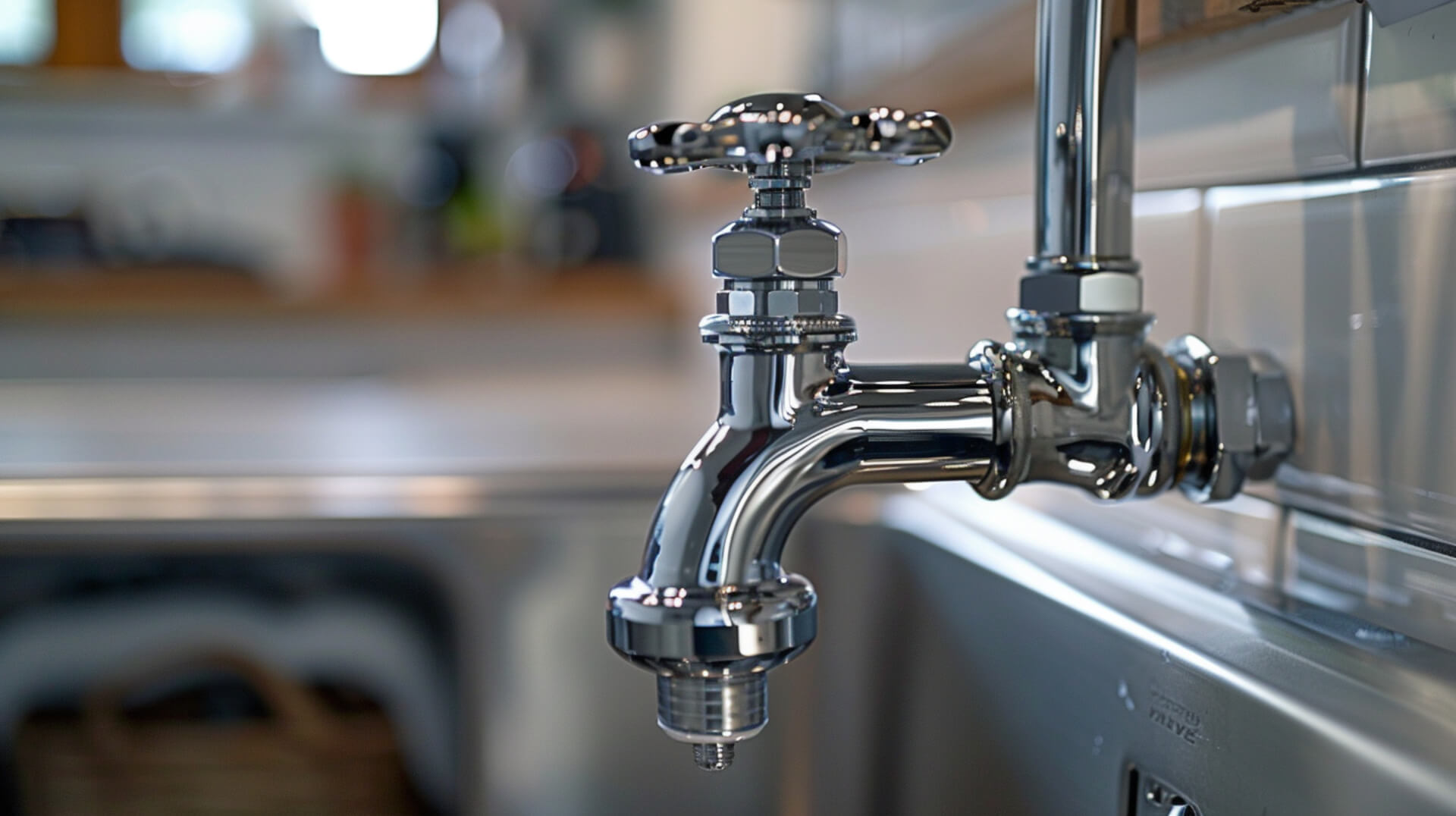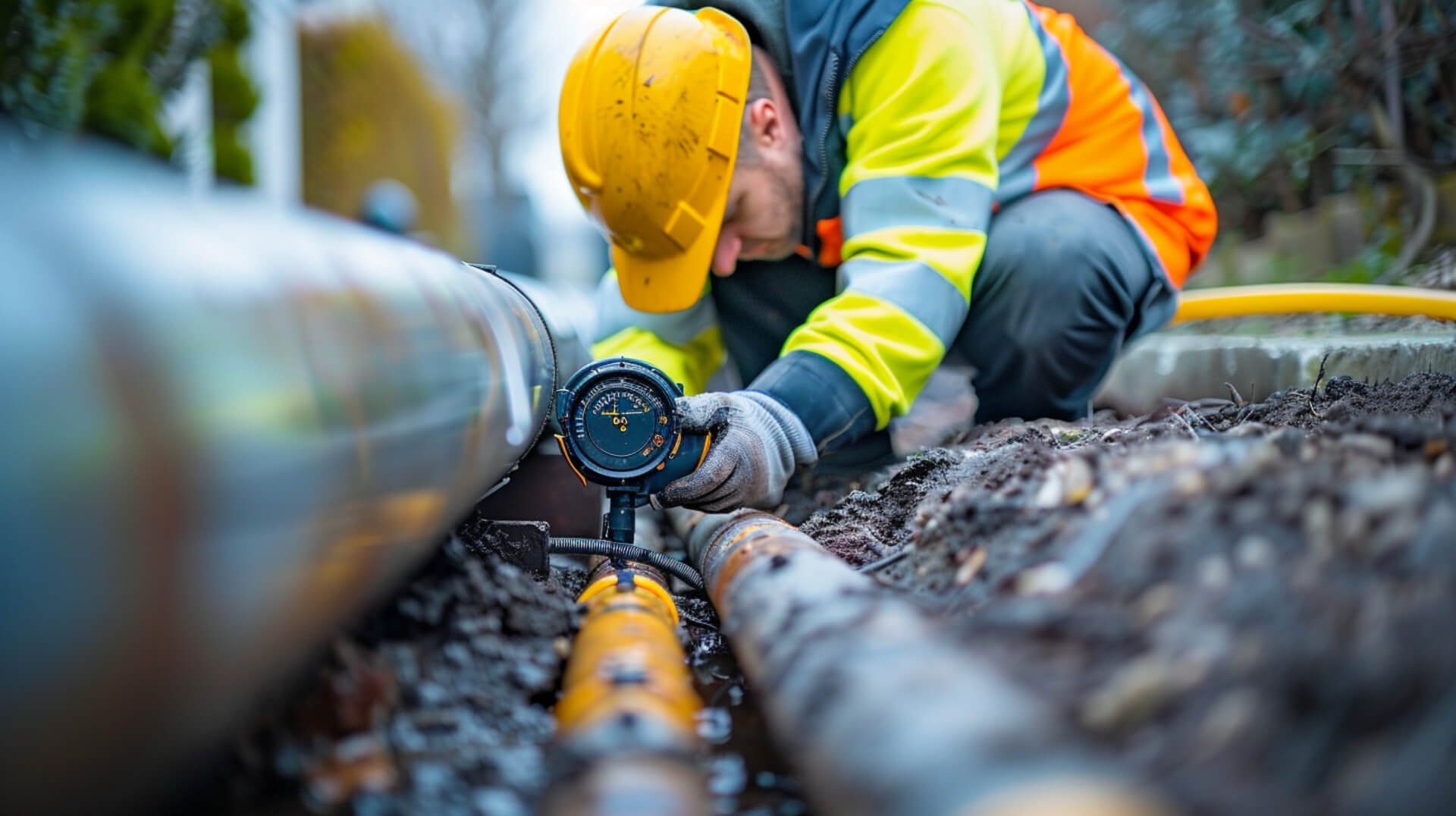 What Is The Process Of French Drain Installation
What Is The Process Of French Drain Installation

What Is a French Drain?
A French drain is a trench filled with gravel or rock containing a perforated pipe that directs surface water and groundwater away from an area. It is a simple, yet effective solution for preventing water from pooling and causing damage to property foundations.
The Functionality of French Drains
The primary function of a French drain is to protect property by redirecting water. It operates on the principle of gravity, allowing water to flow through the gravel and into the pipe, which then carries it safely away from the area.
Effective Installation Locations
French drains are most effective when installed in areas prone to excess water accumulation, such as basements, yards, and near structures. Proper placement ensures that water is channelled away from foundations, preventing potential water damage.
Historical Origins of the French Drain
Contrary to what the name might suggest, the French drain did not originate in France. It was named after Henry French, an American farmer and lawyer from Concord, Massachusetts, who popularised the concept in the 19th century as part of agricultural innovation. His work dispelled the misconception that the system had French origins and established it as a widely adopted method for managing excess water.
The Importance of Proper Planning Before Installation
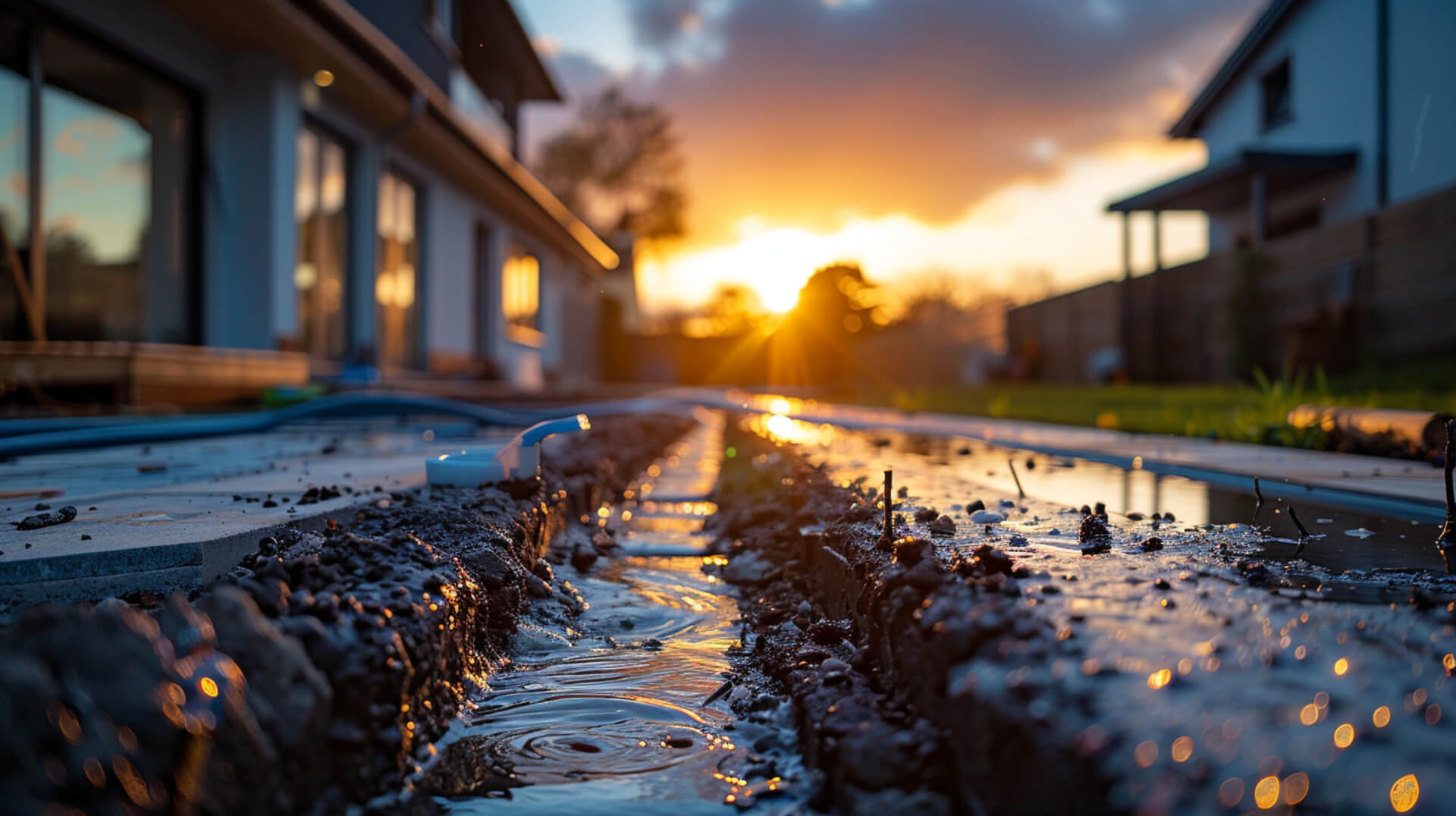
Before embarking on the installation of a French drain, it is imperative to engage in meticulous planning. This phase is foundational to the success of the entire system.
Identifying Water Drainage Issues
Understanding the specific water drainage issues on your property is the first step in planning for a French drain. This involves observing areas where water accumulates or where erosion is evident. Identifying these issues informs the design of the drainage system, ensuring it effectively addresses the water management needs of your property.
Calculating the Slope for Effectiveness
The slope of the trench is a critical factor in the functionality of a French drain. A gradient of at least 1% decline per ten feet is necessary to facilitate proper water flow. Calculating this slope accurately is essential to prevent stagnant water within the system, which could lead to inefficiency or failure.
Consequences of Not Marking Utility Lines
Failing to mark utility lines before digging can result in significant safety hazards and service disruptions. It is crucial to contact local utility companies to identify and mark the location of underground lines. This step not only ensures safety but also helps avoid potential legal and financial repercussions.
Adhering to Local Regulations
Compliance with local regulations is non-negotiable when planning a French drain. Property owners must familiarise themselves with zoning laws, which may dictate the drain’s placement and design. Adherence to these regulations prevents legal issues and ensures that the installation does not negatively impact the surrounding environment or infringe upon neighbours’ properties.
Essential Materials for French Drain Installation
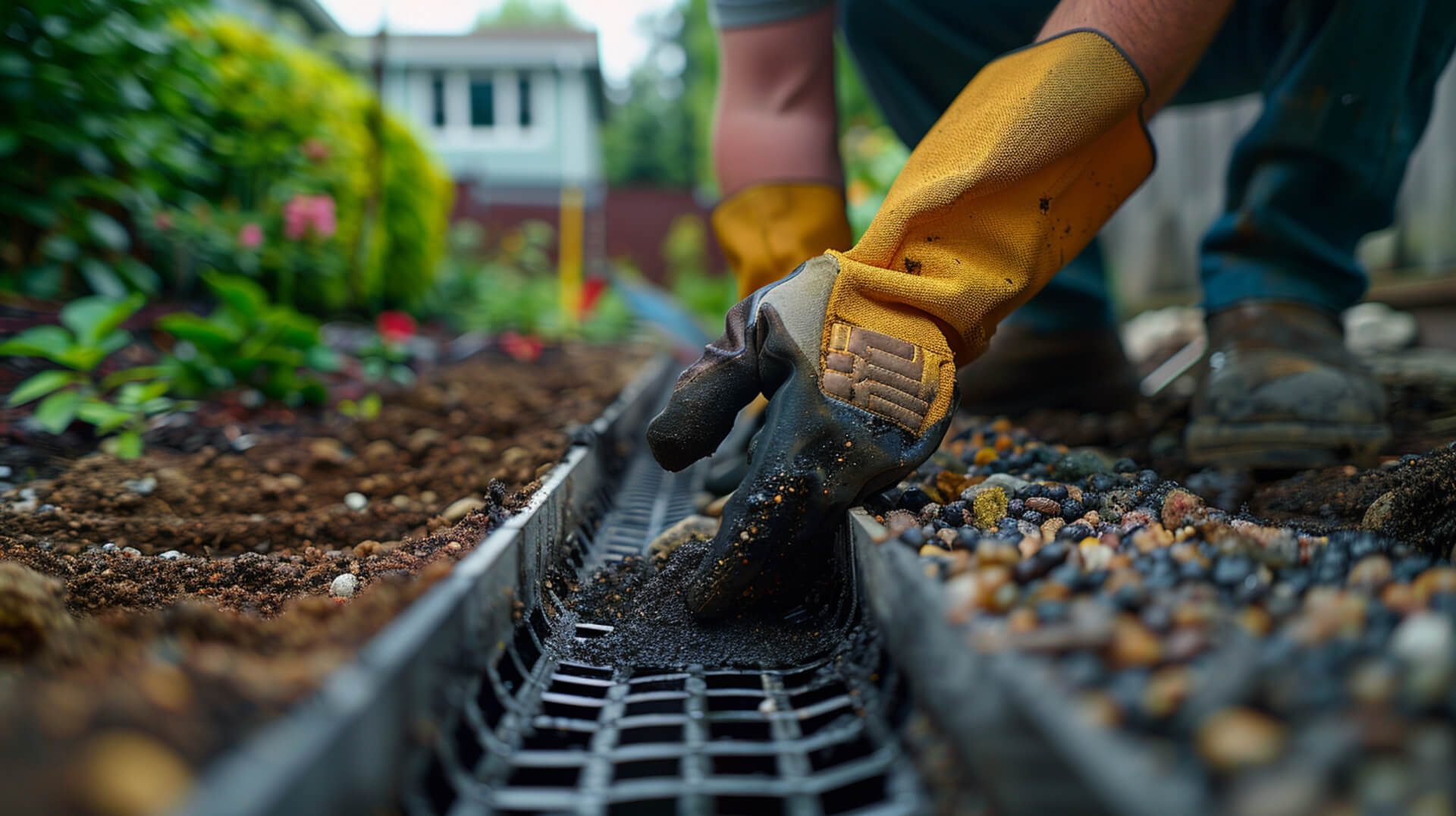
Selecting the appropriate materials is crucial for constructing a French drain that is durable and effective. Understanding the function and quality of each component will ensure that your drainage system performs optimally.
Types of Pipes for French Drains
For a French drain, pipes are a fundamental component. Perforated PVC or corrugated pipes are commonly used due to their durability and effectiveness in water redirection. The perforations allow water to enter the pipe, which is then channelled away from the property.
Importance of Gravel Choice
Gravel plays a vital role in filtering and facilitating water flow into the drain. Medium-sized, angular gravel is recommended as it provides the best filtration and prevents soil from clogging the system. The angular shape allows for better water passage compared to rounded pebbles.
Functionality of Landscape Fabric
Landscape fabric, placed around the gravel and pipes, acts as an additional philtre. It prevents soil intrusion while allowing water to seep through, thus maintaining the efficiency of the French drain over time.
Optional Materials for Enhanced Efficiency
While not essential, certain materials can enhance the French drain’s performance. Rain barrels can be connected to the system for water collection and reuse. This not only conserves water but also manages runoff in an eco-friendly manner.
Step-by-Step Guide to Installing a French Drain
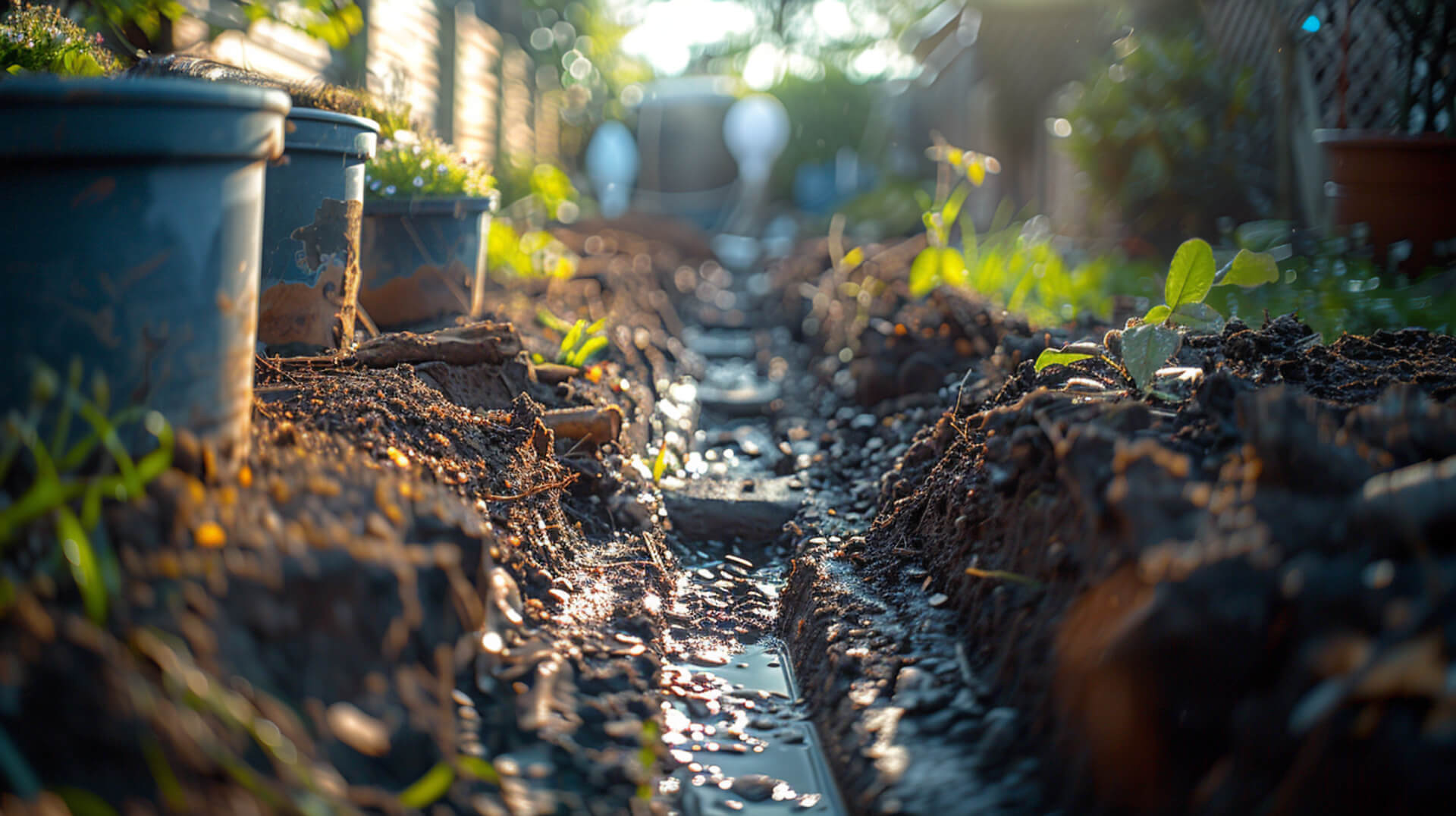
Installing a French drain is a systematic process that requires precision and attention to detail. The following steps outline the method for creating an effective drainage system.
Preparing the Trench
The initial phase involves digging a trench that will house the French drain. The trench should be approximately 6 inches wide and 18 to 24 inches deep, although these dimensions can vary based on specific needs. It is essential to ensure that the trench has a consistent slope, ideally with a 1% decline for every ten feet of length to facilitate water flow.
Laying the Pipe and Gravel
Once the trench is prepared, the next steps are as follows:
- Line the trench with landscape fabric to prevent soil from clogging the gravel and pipes.
- Add a layer of medium-sized angular gravel to the bottom of the trench.
- Place the perforated pipe on top of the gravel, ensuring it lies flat and follows the trench’s slope.
- Cover the pipe with more gravel, leaving a few inches from the top of the trench.
Ensuring Slope Adherence
Maintaining the correct slope throughout the assembly process is critical. This slope ensures that gravity will effectively draw water through the pipe, away from the property.
Backfilling and Finishing
To complete the installation:
- Wrap the excess landscape fabric over the top of the gravel.
- Backfill the trench with topsoil, which can then be seeded with grass or covered with mulch, depending on the surrounding landscape.
- Conduct a water test to confirm that the drain is functioning correctly, making adjustments as necessary.
Location Considerations for Maximum Efficiency
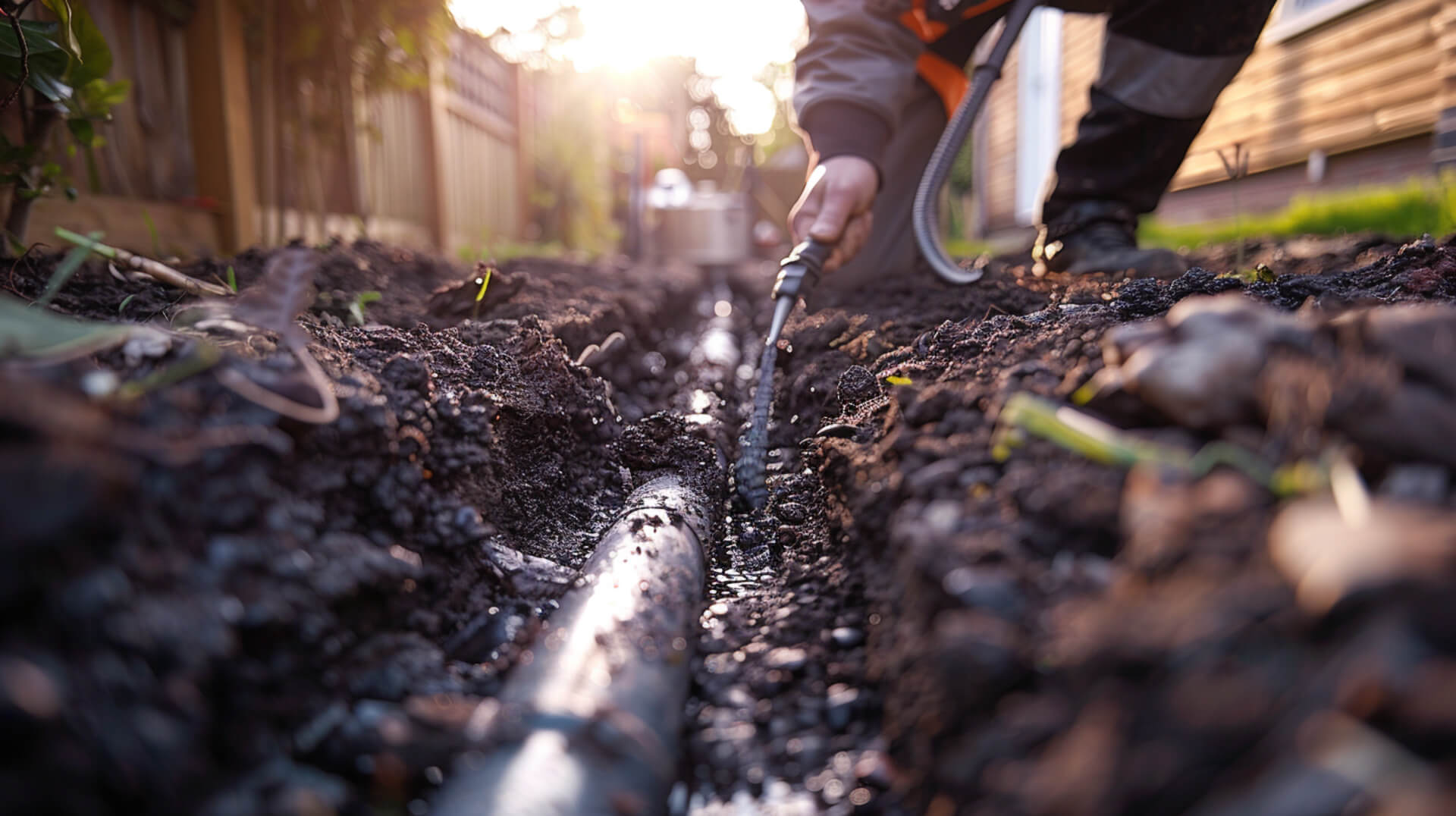
Choosing the right location for a French drain is critical to its effectiveness in protecting your property from water damage. Here are key factors to consider when determining the optimal placement for your French drain system.
Proximity to Basements, Yards, and Structures
The placement of a French drain should be strategic to address specific water management concerns. Installing it near basements can prevent water infiltration that leads to dampness or flooding. In yards, the drain should be situated to intercept and redirect surface water away from landscaped areas and structures, thus preserving the integrity of the property.
Impact of Land Slope and Tree Roots
The natural slope of the land influences how water flows and accumulates, which in turn affects where a French drain should be located. Additionally, tree roots can obstruct the trench or damage the pipes, so it is important to plan the drain’s path to avoid these potential issues.
Navigating Legal and Public Implications
When installing a French drain, you must consider legal and public implications, such as adhering to zoning laws and avoiding utility lines. It is essential to obtain any necessary permits and ensure that the drain does not adversely affect neighbouring properties or public spaces.
Zoning Laws and Utility Line Avoidance
Navigating zoning laws is a non-negotiable aspect of French drain installation. Contacting local authorities for guidelines and having utility lines marked are steps that cannot be overlooked. These measures ensure safety, legal compliance, and uninterrupted utility services during and after the installation process.
Routine Maintenance and Cleaning for Longevity

Maintaining a French drain is essential to ensure it continues to protect your property from water damage effectively. Regular inspections and cleanings can prevent system failures and extend the lifespan of the drain.
Conducting Routine Inspections
A routine inspection of your French drain should occur at least annually. During this inspection, check for signs of sediment build-up, pipe damage, or visible clogs. It’s also important to assess the area for erosion or changes in landscape that could affect the drain’s performance.
Clearing Debris and Managing Erosion
To clear debris from the French drain, remove any visible obstructions from the drain’s opening and ensure that the exit point is free-flowing. If erosion is noted, consider adding more gravel or adjusting the slope to better manage water flow.
Recommended Cleaning Methods
For cleaning, flush the system with a garden hose to remove minor sediment. For more significant blockages, an electric sewer snake or pressure washer may be necessary. Always wear appropriate safety gear when performing these tasks.
Identifying and Resolving Clogs
Clogs can be identified by slow drainage or water backup. To resolve clogs, remove the drain cover and inspect for blockages. Flush the system with water, and if the clog persists, use a sewer snake to dislodge it. Repeat the process until water flows freely.
Deciding Between DIY and Professional Installation
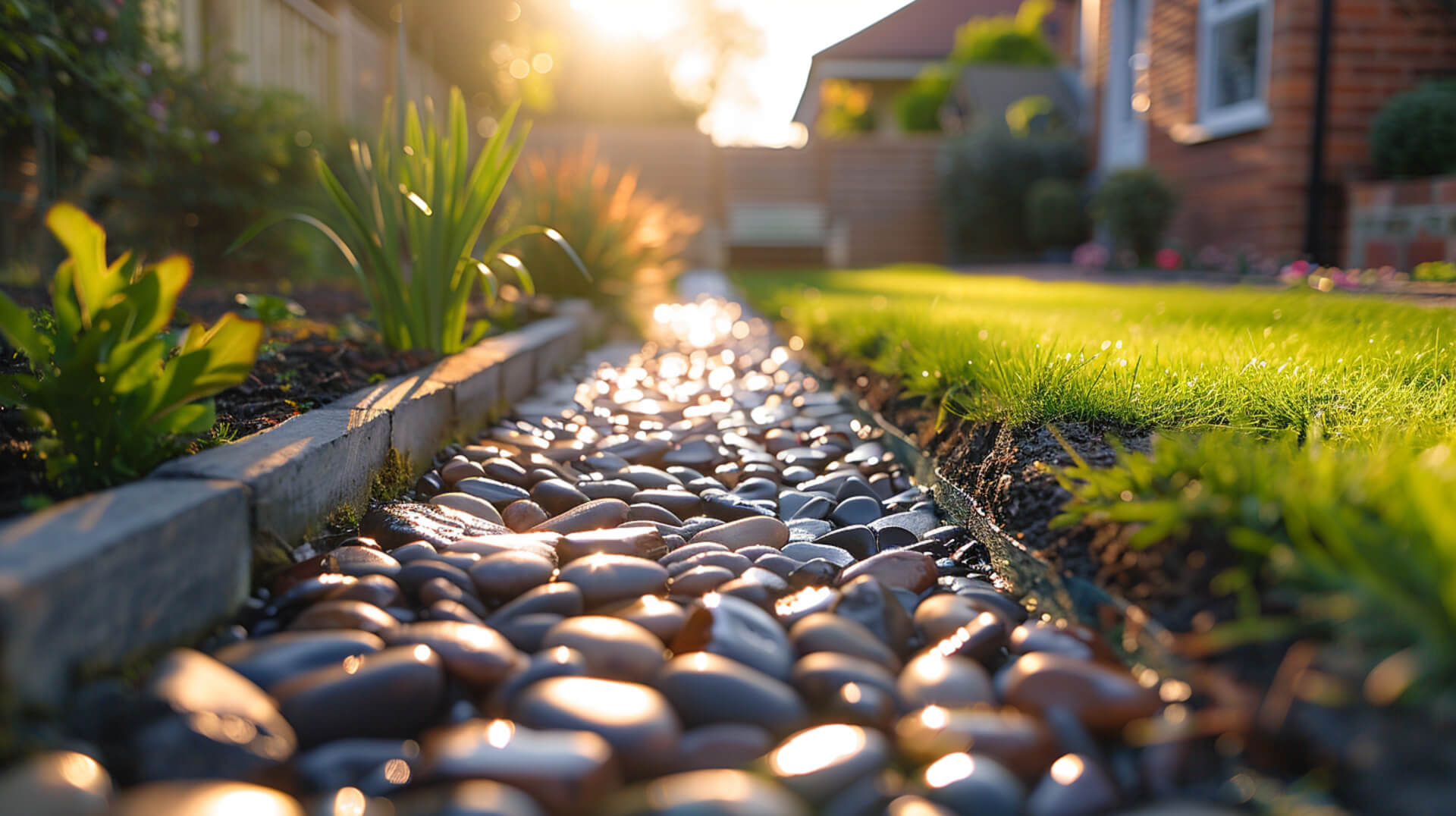
When contemplating the installation of a French drain, property owners must weigh the decision to undertake the project independently or to enlist professional services.
Assessing Project Complexity and Labour Intensity
The complexity of a French drain installation can vary greatly. Simple projects may be manageable for those with DIY experience, while more complex installations, particularly those that involve navigating around utilities or ensuring compliance with strict regulations, may necessitate professional expertise. Labour intensity should also be considered; the physical demands of excavation and installation may be too strenuous for some individuals.
Evaluating Cost Benefits
Cost is often a significant factor in the decision-making process. While a DIY approach may reduce expenses related to labour, the potential for mistakes that could lead to costly repairs should not be overlooked. Conversely, professionals, with their expertise and specialised equipment, may offer a more cost-effective solution in the long term, especially for intricate projects.
When Professional Installation Is Recommended
Professional installation may be recommended for projects that require customised solutions, such as those involving unique landscape features or significant water management challenges. Professionals can provide valuable insights into the most effective design for your specific needs and ensure that the installation is completed efficiently and in compliance with all relevant regulations.
Common Pitfalls in French Drain Installation and How to Avoid Them

Installing a French drain involves more than just digging a trench and laying pipe. Awareness of common installation errors can save you from future headaches and ensure the longevity and effectiveness of your drainage system.
Avoiding Incorrect Slope and Unlined Trenches
One of the most frequent mistakes is neglecting the proper slope for the trench. Without the correct gradient1% decline per ten feetwater will not flow effectively. Always use a level during installation to maintain the slope. Additionally, failing to line the trench with landscape fabric can lead to clogging from sediment and roots. Ensure the trench is properly lined before adding gravel and pipes.
The Crucial Role of Material Selection
Selecting the right materials is vital. Inappropriate gravel size or the wrong type of pipe can compromise the system’s functionality. Medium-sized, angular gravel and perforated pipes are recommended for optimal water filtration and flow.
Ensuring Compliance with Zoning and Regulatory Requirements
Compliance with local zoning laws and regulations is not optional. Before installation, consult with local authorities to understand the requirements. This includes obtaining necessary permits and ensuring that the drain’s placement does not negatively impact neighbouring properties or violate any environmental regulations.
Enhancements and Alternatives to Traditional French Drains
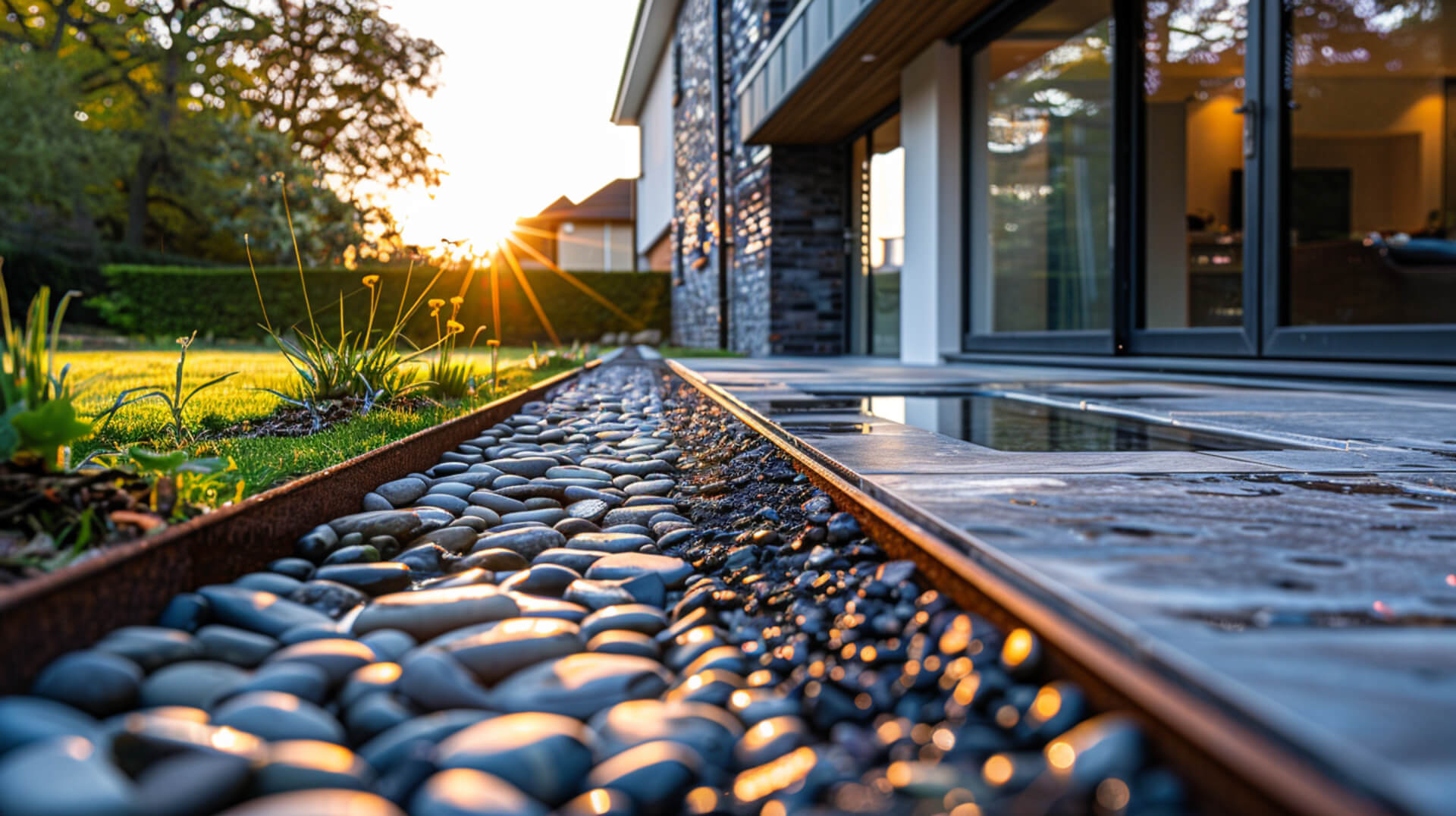
In the realm of drainage solutions, traditional French drains have stood the test of time. However, modern enhancements and alternatives offer additional benefits that may suit your specific needs.
Prefabricated Pipes and Catch Basins
Prefabricated pipes, with their built-in philtres and easy-to-connect segments, streamline the installation process and enhance the long-term reliability of the drainage system. Catch basins serve as a preliminary collection point for runoff, trapping larger debris before it enters the French drain, thus reducing the likelihood of clogs.
Integrating Rain Barrels for Water Conservation
Incorporating a rain barrel into your French drain system allows for the collection and reuse of water, which is an eco-friendly alternative to simply diverting it away. This collected water can be used for irrigation, conserving water and reducing utility bills.
Benefits of Drainage System Enhancements
These enhancements can lead to a more efficient drainage system that requires less maintenance. Prefabricated pipes reduce the risk of improper installation, and catch basins make cleaning easier. Rain barrels not only conserve water but also help manage water flow during heavy rainfall, reducing the burden on the drainage system.
The Environmental and Neighbourly Impact of French Drains
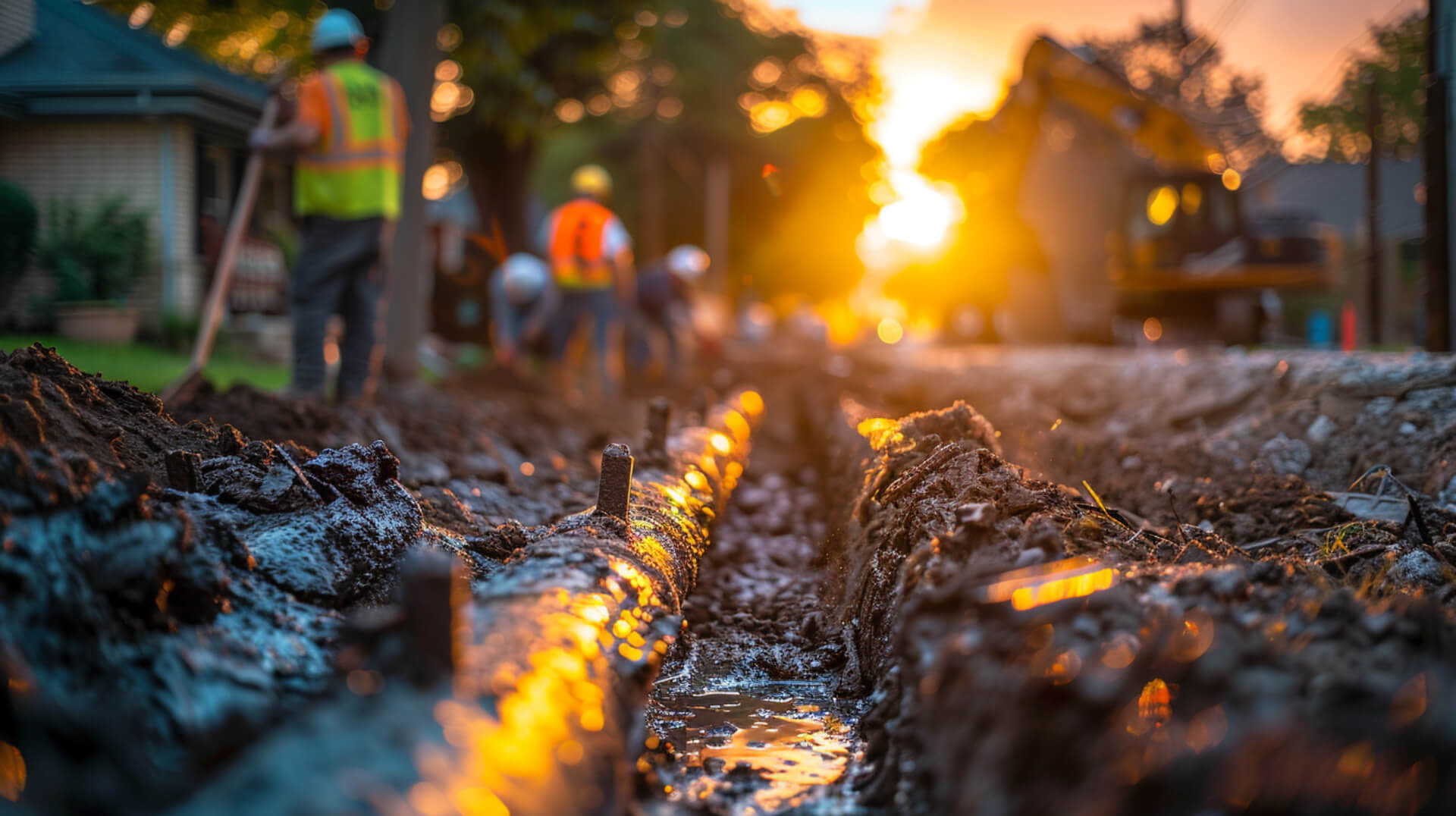
French drains serve a critical role in managing water runoff and minimising environmental impact. Properly designed and installed, these systems can significantly reduce the spread of toxins and protect neighbouring properties from water damage.
Controlling Runoff and Minimising Toxin Spread
French drains redirect excess water, which can carry soil contaminants and pesticides away from your property. By managing runoff, these systems help to prevent the spread of potential toxins into nearby water bodies or neighbouring lands.
Importance of Drainage Endpoint Consideration
The endpoint of a French drain is where the redirected water is discharged. It is crucial to ensure that this point does not lead to water pooling in unintended areas or causing erosion. The endpoint should be carefully planned to direct water into a suitable area, such as a dry well or a rain garden, which can naturally philtre the water and minimise environmental impact.
Ensuring an Environmentally Friendly System
To ensure that your French drain is environmentally friendly, consider using sustainable materials and incorporating features like rain barrels for water collection. This not only conserves water but also reduces the volume of runoff that needs to be managed.
Mitigating Negative Impacts on Neighbours
To mitigate any negative impacts on neighbours, it is essential to design the French drain system in a way that respects property boundaries and local water flow patterns. Communication with neighbours about your drainage plans can help prevent disputes and ensure that the system benefits the broader community.
Navigating Challenges and Solutions in French Drain Installation
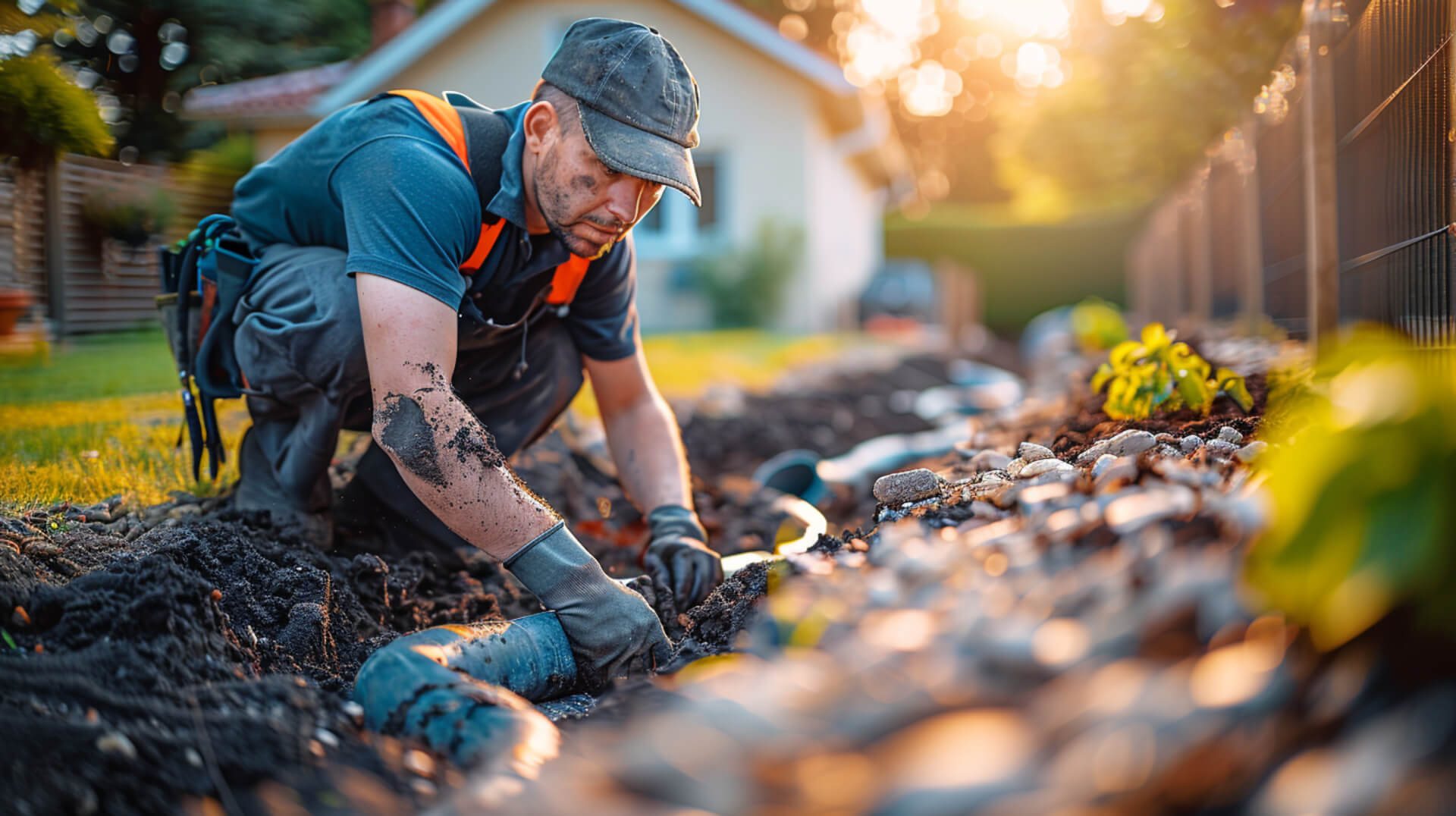
Installing a French drain involves several challenges, from the complexity of the installation to the ongoing maintenance demands. Understanding these challenges and preparing for them can ensure a successful installation and long-term functionality.
Addressing Installation Complexity
The complexity of installing a French drain can vary depending on the landscape and the specific water management needs of your property. It’s important to thoroughly plan the project, considering factors such as the slope of the land, the type of soil, and the proximity to structures. Detailed planning can help mitigate the complexity and ensure that the installation process goes smoothly.
Seeking Professional Assistance
For complex or large-scale projects, seeking professional assistance is advisable. Professionals bring expertise, experience, and the right equipment to handle the installation efficiently. They can navigate any regulatory requirements and foresee potential issues that may not be apparent to the untrained eye.
Preparing for Potential Clogs and Maintenance
To prepare for potential clogs and maintenance issues, property owners should establish a routine inspection and cleaning schedule. This includes checking for signs of water backup, slow drainage, and ensuring that the exit point of the drain remains clear. Having the necessary tools on hand, such as a sewer snake or pressure washer, can aid in addressing clogs promptly.
By anticipating these challenges and taking proactive steps, property owners can ensure the longevity and effectiveness of their French drain system.
Ensuring Comprehensive Planning in French Drain Installation

To ensure a successful French drain installation, property owners must cover all bases in planning and execution. This includes conducting a thorough assessment of water drainage issues, calculating the necessary slope, and choosing the correct materials. It is also essential to adhere to local zoning laws and utility guidelines.
Critical Maintenance for Long-Term Success
Ongoing maintenance is vital for the longevity of a French drain. Regular inspections can prevent clogs and system failures. Property owners should clear debris annually and consider a professional inspection biennially to maintain optimal functionality.
Conducting Final Checks Post-Installation
After installation, several checks are necessary to confirm the effectiveness of the French drain. These include verifying the slope of the trench, ensuring that water flows freely through the system, and checking that the exit point is clear and properly dispersing water.
Staying Informed on French Drain Best Practices
Staying informed about best practices and new developments in French drain technology is beneficial. Property owners can consult with professionals, attend workshops, or join online forums dedicated to home improvement and landscaping to keep up-to-date with the latest techniques and materials.

